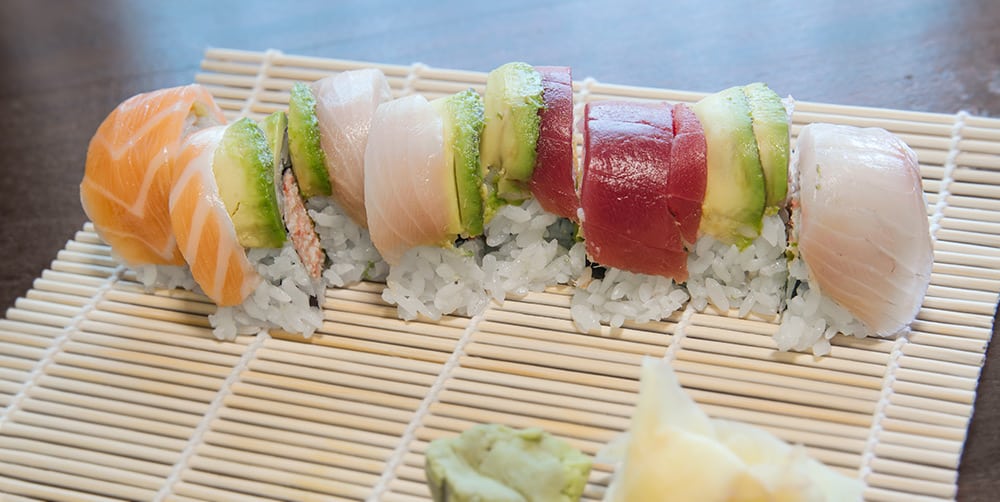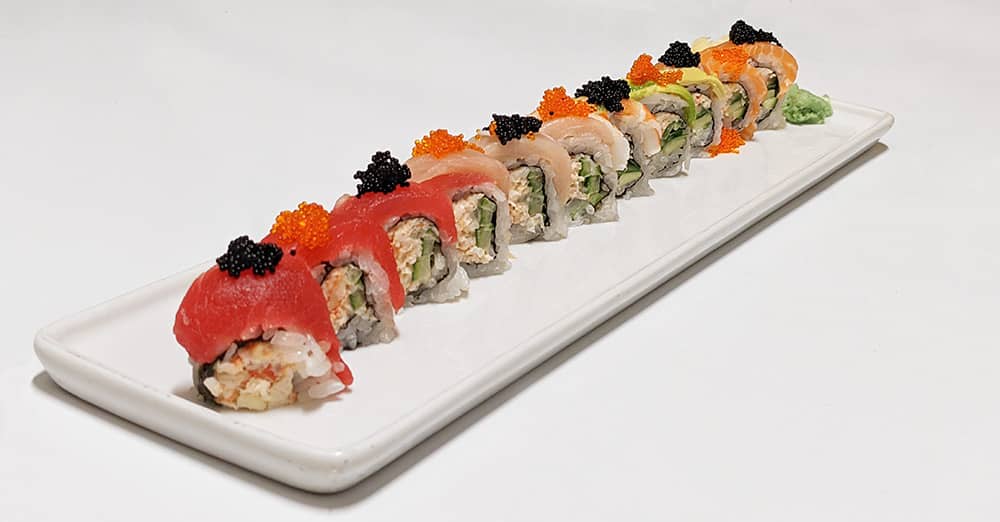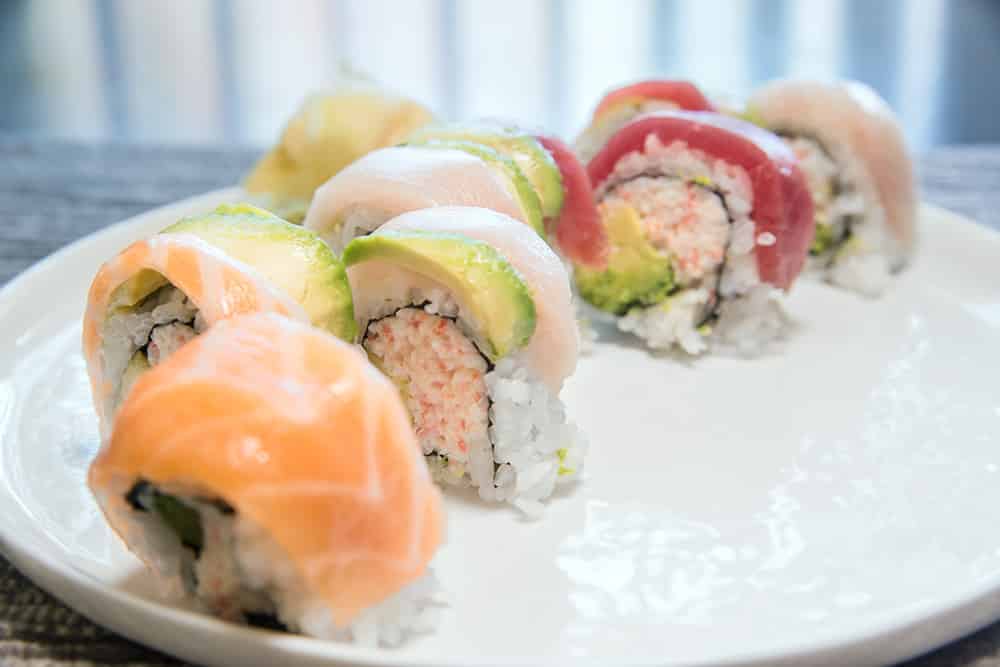Are you looking to adventure outside of beginner’s sushi dishes like spicy tuna and California rolls? The rainbow roll is the ultimate gateway sushi, and it’s delicious.
This post answers the major frequently asked questions for this sushi classic. Learn its history, ingredients, and more.

What is a Rainbow Roll?
A rainbow roll is an evolution of the California roll. It’s an uramaki, where the rice is on the outside. Inside, you’ll find crab or imitation crab, avocado, and cucumber. Different types of seafood are placed over the top, along with more avocado, giving it a colorful appearance.
Revolutionary L.A. Sushi
Hiding the nori seaweed by making maki sushi inside-out sparked a revolution. The use of avocado in sushi was another novel idea. These two ideas came together to make the California roll.
But the use of colorful cuts of raw fish over the top of an uramaki was a further evolution in Western sushi.
The originator of the rainbow roll is unknown. However, it’s thought to have come from the Little Tokyo neighborhood of Los Angeles in the late 1960s or early 1970s. Since it’s likely the uramaki and the California roll originated there, it makes the most sense for the rainbow roll, as well.
Does a Rainbow Roll Have Raw Fish?
Yes, rainbow rolls use raw fish. Raw salmon, tuna, and yellowtail are the most common ingredients you’ll find on top of this sushi roll. Sometimes white fish (shiromi) are used like madai, suzuki, or hirame. They will also be raw.
This American sushi classic sometimes uses cooked shrimp (ebi) on top. Rainbow rolls also use cooked crab or imitation crab inside.

Rainbow Roll Ingredients
The rainbow roll has no set list of ingredients. But most of the time, it’s made with the ingredients listed below.
What Does a Rainbow Roll Have in It?
The inside of a rainbow roll is essentially a California roll, which consists of crab or imitation crab and avocado. Additionally, it wouldn’t be a sushi roll without sushi rice and nori seaweed. Cucumber and Japanese mayo are both common ingredients, as well. Lastly, sesame seeds and masago or tobiko are common.
Some restaurants will substitute shrimp tempura inside instead of crab. But this isn’t common, however.
What’s on Top of This Roll?
Rainbow rolls are colorful. Avocado slices and various types of seafood are arranged on top. And each type of seafood has a different color.
The most common choices of fish are salmon, tuna, and yellowtail. Whitefish like snapper, sea bream, flounder, or sea bass are also frequently used. And shrimp is another common ingredient that gives a rainbow roll a colorful look.
Additionally, some rolls are topped with masago or tobiko.
Popular Variations
Check out the most popular variations of this modern classic.
Spicy Rainbow Roll
Spicy rainbow rolls are the most common variation. The spice usually comes from either spicy mayo or Sriracha mixed with the crab.
Occasionally, chefs will use jalapeno, wasabi tobiko, or wasabi aioli to make a spicy rainbow.
Tuna Rainbow Roll
This sushi roll frequently results from using a spicy tuna roll inside instead of a California roll. Other times tuna and avocado are used inside. Either way, the top will be the same.
Salmon Rainbow Roll
A salmon rainbow roll will use salmon, avocado, and sometimes cucumber instead of crab. The top will remain the same.

How Many Pieces are in this Roll?
It’s most common to find rainbow rolls cut into eight or ten pieces.
Is a Rainbow Roll Good for Beginners?
Because this sushi roll visibly utilizes raw fish, it may not be the best choice for sushi neophytes. A simple California roll is a better choice if you’re wary of raw fish.
However, because the rainbow roll features a healthy amount of cooked crab or imitation crab and avocado, it doesn’t leave a heavy impression of raw fish. For this reason, it makes a great bridge from beginner-friendly sushi to more advanced and traditional options.
How to Eat a Rainbow Roll
It’s customary to eat inside-out rolls with chopsticks as the sushi rice can stick to your fingers. However, the toppings on this roll can make this approach challenging. Therefore it’s ok to eat rainbow rolls with your hands if you prefer.
Using soy sauce and wasabi are also totally acceptable. Be mindful that the rice will easily absorb the former ingredient. Too much soy sauce can overpower the flavors of a rainbow roll. So it’s best to be careful while dipping your pieces.
Is a Rainbow Roll Gluten Free?
Most of the ingredients in a rainbow roll are gluten-free. However, Japanese mayo is typically mixed with the crab or imitation crab. This ingredient contains gluten. Additionally, care must be taken if masago or tobiko are used. Soy sauce is often used to marinate these two fish roes. When in doubt, omit the roe.